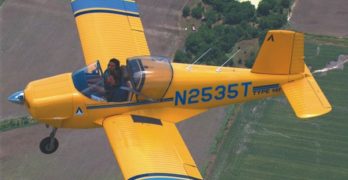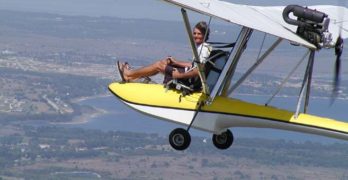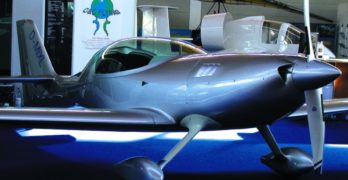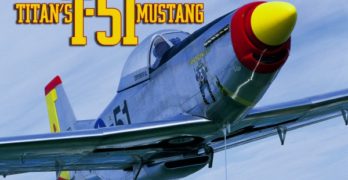Finally! ByDanJohnson.com Goes LiveST. PAUL, MINN. – After three years of effort, Dan Johnson is pleased to announce that his Web site will go live on April 12th, 2004, the day before the season-starting Sun ‘n Fun airshow opens.
ByDanJohnson.com is intended to be a source for literally hundreds of pilot reports on a wide variety of light aircraft, accompanied by thousands of photos of these aircraft. Dan’s work to create pilot reports dates back into the mid-1970s and covers a large fleet of ultralights and light-sport aircraft made in the USA or abroad.
“This is one of those projects where if I’d known how much work it was going to be, I might never have started,” admitted Johnson. “But, at airshows and at speaking engagements, pilots often ask, ‘You’ve flown all these airplanes. Which one should I buy?’ The question is difficult to answer because each person has different skills and needs, and I don’t usually know the individual asking the question,” Dan explained.
Search Results for : Ultralight April
Not finding exactly what you expected? Try our advanced search option.
Select a manufacturer to go straight to all our content about that manufacturer.
Select an aircraft model to go straight to all our content about that model.
Thorp T-211
Thorp T-211 Sport E
From the world of general aviation aircraft comes an entry to the proposed Light-Sport Aircraft (LSA) category. Presently known as the Thorp T-211, the all-metal airplane will be called the Thorp T-211 Sport E when it makes its debut as a light-sport aircraft.
Famed designer John Thorp is perhaps best known for his work leading to the Piper Cherokee series and the T-18 homebuilt. His work on a design that became the T-211 started back in the 1940s before general aviation planes had transportation as their primary goal. When the T-211 was first created – as the T-11 Skooter and later the T-111 – it was intended to become competition for the Cessna 150. The T-211 is a light plane, tipping the scales at hundreds of pounds less than Cessna’s smallest model and so it was expected to perform better.
Under new management since 2003, Thorp’s design is ready to make the leap to the Sport E.
Connie Amphib — “The Flying Float” (and it is!)
Check out Bobbie Bailey’s Connie Amphib.
Many pilots are aware of aircraft referred to as flying boats. Among ultralight aircraft, the Aventura, SeaRey and Buccaneer stand out as good examples as do trikes like Polaris’ Flying Inflatable Boat. The flying boat reference describes those aircraft built around a boat hull with substantially different structure than airplanes equipped with two floats.
That clear definition is blurred by the introduction of a novel new ultralight from the inventive mind of Bobbie Bailey. His new Connie amphibian is neither flying boat nor a float-equipped ultralight. My BRS associate, Gregg Ellsworth, tagged it a “flying float.” Works for me.
Canada’s Lotus Float company offers a single float setup that functions much the same way but is an add-on to a wheeled ultralight. This may make a perfectly fine floatplane, but you have to do the fitting yourself, and it simply won’t be as elegant as Bailey’s Connie amphib.
Product Lines – May 2004
ST. PAUL, MINN. — Time is growing short! Perhaps by the time you read this, FAA
may have issued their new rule called Sport Pilot/Light-Sport Aircraft
(SP/LSA). Why should you care? Well, perhaps you don’t.
If you fly solo in your hang glider or paraglider and are not towed aloft by a tug
of some kind, you may continue to operate under F.A.R. Part 103 as blissfully as
ever. However, if you’re one of the many who enjoy aerotow launches, you may be impacted
by this rule. The good news is| the trio of Jayne
Depanfilis, Mike Meier, and Bill Bryden have been pursuing actions on the new rule
and have the matter quite well in hand. The issues of two-place flying have been
addressed and face few obstacles. Aerotowing, however, is less certain.
Operations such as Lookout Mountain Flight Park have been fighting local battles
with adversaries who brought FAA into the picture.
Tuning Up Skystar
SkyStar reorganizes to offer ultralights, homebuilts and special LSAs under “one” roof.
For the new SkyStar Aircraft Corp., the light at the end of the proverbial tunnel is not a locomotive; it’s the coming of a bright new day in light aviation. As the publication of the final sport pilot and light-sport aircraft (SP/LSA) rule looms on the horizon, business is looking better for SkyStar and most other manufacturers and suppliers of light aviation equipment.
The two-place SkyStar Series 7 will have multiple personalities. SkyStar Sport Planes will manufacture a variation of this model as a ready-to-fly special LSA. Depending on the parameters of the final rule, SkyStar Sport Planes may sell an experimental LSA kit (more than 51-percent complete). When flown as an LSA, the Series 7 will be limited to the Rotax 912S engine as its powerplant. SkyStar Aircraft will continue to offer the Series 7 as a 51- percent amateur-built kit, with a variety of engine options, including the 914 Turbo version shown here.
Europe’s Biggest Light Aircraft Show
Light-sport aircraft are a major part of Aero 2003
My first visit to the Aero show was in 2001. For years earlier, I’d been aware of this event in the far south of Germany, in the resort town of Friedrichshafen. After attending the show two years ago, I became aware of how important it would be to light-sport aircraft.
Because Aero runs on alternate years, like many air shows in Europe, I determined I was going again in 2003, no matter what. Once again it was a worthwhile trip.
Friedrichshafen sits on the northern shore of a giant lake called Bodensee or Lake Constance. Across the body of water to the south lies Switzerland. Bodensee’s eastern edge borders Austria. The tourist attractions generated by the big lake come with picturesque scenes in many directions.
Friedrichshafen is also home to the Zeppelin airship company. Famous for its creation of the Hindenburg, Zeppelin is the oldest continuously operating airship builder.
Relive the World War II fighter experience
The Ending
In the remainder of this article I’ll tell you what I thought of this new offering from Titan Aircraft, the successful builder of the Tornado line of ultralights and light aircraft. But I must be forthright and tell you my hour and a quarter flight with this new airplane ended with a landing on its belly.
I rush to say it wasn’t simple forgetfulness; I didn’t forget to put the gear down. Instead, a simple mechanical problem in this prototype T-51 prevented the retractable gear from fully extending. The gear was partially down, but it refused to lock in position. A post-incident investigation revealed that a tiny activation pin broke off the gear-down microswitch when I tried to activate it with too forceful a movement. Because the micro-switch didn’t activate, the hydraulic system didn’t push the gear legs down all the way.
Considering the gear was down only about 50 percent, according to Titan President John Williams who was watching from the ground, my touch down was remarkably smooth, and the T-51 rolled for quite a few yards.
Product Lines – December 1999
ST. PAUL, MINN., — As we head in winter and the holiday season, news for the next season appears to continue a focus on rigid wing hang gliders. Flexwings continue to do well in contest flying (and sales) but we simply aren’t hearing as much about new developments as we have in years past… for example, the topless buzz is now getting to be some years old. ••• U.S. Aeros is preparing for sale of their new rigid wing, ominously named the Stalker. It either sounds like a challenger trying to take on the leader (Exxtacy and ATOS, by almost any reckoning), or like a johnny-come-lately rigid wing design. Certainly for a company that has shown the ability to compete in the worldwide hang gliding community — for both sales, at which they’ve done excellently, and in competitions — Aeros is somewhat tardy bringing their stiffwing to market. • On the other hand, this is a second generation offering like the Ghostbuster and ATOS.
Product Lines – July 1999
ST. PAUL, MINN., — The glare of spotlights this month turns to GW Meadow’s U.S. Nationals which took place at Quest Air the week after Malcolm Jones’ Wallaby Open concluded. ••• Weather wasn’t quite as cooperative and the organization was different, but the U.S. Nationals are now history and Jim Lee is our national champion, edging out top-ranked Mike Barber by a mere seven points (nothing, really, in the course of a whole contest week). Prior to the two Florida events, Barber had been #1 ranked in the U.S. team scheme though new stats will now be needed. • Neither man outdid the dynamic duo of Manfred Ruhmer and Oleg Bondarchuk (ranked #4 and #1 in the world scheme prior to these two meets). In addition, web writer Davis Straub also indicated several pilots from Brazil did well… as all these non-USA pilots had done at the Wallaby meet. • All in all, Florida was host to two grand events and both are angling for a repeat next year, so say the rumor mills.
Product Lines – June 1999
WALLABY RANCH, FLA. — In a rare state of upset, the focus of American hang gliding — even the focus of the world, perhaps — is on the eastern half of the U.S. In two remarkable back-to-back weeks, Florida took center stage of world of hang gliding competitions. It all started with the Wallaby Open and ended with the U.S. Nationals, however, as this column tries to sneak off to the printer at the last possible second, I’ll speak about the already-concluded Wallaby Open this month and next month will report more from GW Meadow’s U.S. Nationals at Quest Air. Fair enough? ••• Malcolm Jones’ kingdom of flight was the site of the Wallaby Open and I was able to make the opening once again as it trails the Sun ‘n Fun airshow which I attend for work. • With good lift, fast racing, and superlative hospitality, the Wallaby Open was well received by a number of pilots who made comments, including the top two finishers, Manfred Ruhmer and Oleg Bondarchuk.
- « Previous Page
- 1
- …
- 14
- 15
- 16
- 17
- 18
- …
- 21
- Next Page »






